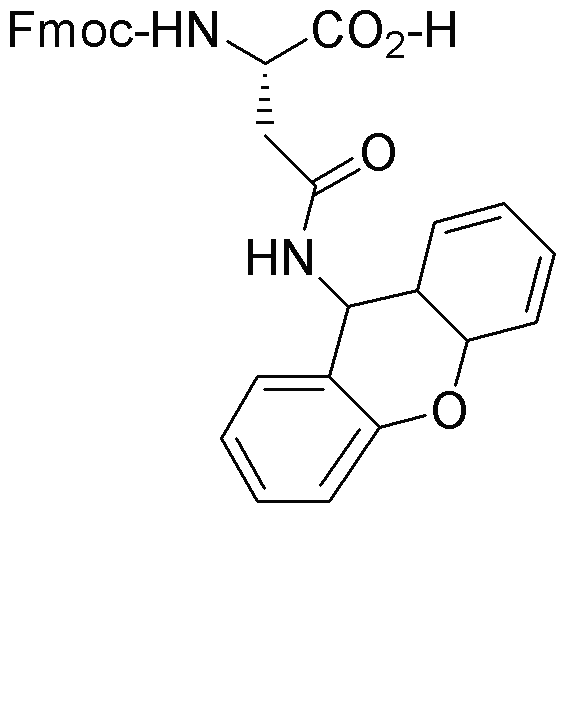Na-Fmoc-Ng-xanthyl-L-asparagine is widely utilized in research focused on:
- Peptide Synthesis: This compound serves as a protective group in peptide synthesis, allowing for the selective modification of amino acids. Its stability under various reaction conditions makes it a preferred choice for chemists working on complex peptide sequences.
- Drug Development: In pharmaceutical research, it is used to create peptide-based drugs. Its unique structure can enhance the bioavailability and efficacy of therapeutic peptides, making it valuable in the development of new medications.
- Bioconjugation: The chemical is employed in bioconjugation processes, where it helps attach biomolecules to surfaces or other molecules. This application is crucial in creating targeted drug delivery systems and diagnostic tools.
- Fluorescent Probes: Due to its xanthene moiety, it can be used in developing fluorescent probes for biological imaging. This application is particularly beneficial in cellular studies, allowing researchers to visualize cellular processes in real-time.
- Research in Protein Engineering: It plays a significant role in protein engineering, aiding in the design of proteins with enhanced stability and functionality. This is particularly important in fields like biotechnology and synthetic biology.
General Information
Properties
Safety and Regulations
Applications
Na-Fmoc-Ng-xanthyl-L-asparagine is widely utilized in research focused on:
- Peptide Synthesis: This compound serves as a protective group in peptide synthesis, allowing for the selective modification of amino acids. Its stability under various reaction conditions makes it a preferred choice for chemists working on complex peptide sequences.
- Drug Development: In pharmaceutical research, it is used to create peptide-based drugs. Its unique structure can enhance the bioavailability and efficacy of therapeutic peptides, making it valuable in the development of new medications.
- Bioconjugation: The chemical is employed in bioconjugation processes, where it helps attach biomolecules to surfaces or other molecules. This application is crucial in creating targeted drug delivery systems and diagnostic tools.
- Fluorescent Probes: Due to its xanthene moiety, it can be used in developing fluorescent probes for biological imaging. This application is particularly beneficial in cellular studies, allowing researchers to visualize cellular processes in real-time.
- Research in Protein Engineering: It plays a significant role in protein engineering, aiding in the design of proteins with enhanced stability and functionality. This is particularly important in fields like biotechnology and synthetic biology.
Documents
Safety Data Sheets (SDS)
The SDS provides comprehensive safety information on handling, storage, and disposal of the product.
Product Specification (PS)
The PS provides a comprehensive breakdown of the product’s properties, including chemical composition, physical state, purity, and storage requirements. It also details acceptable quality ranges and the product's intended applications.
Certificates of Analysis (COA)
Search for Certificates of Analysis (COA) by entering the products Lot Number. Lot and Batch Numbers can be found on a product’s label following the words ‘Lot’ or ‘Batch’.
Número de catálogo
Número de lote/lote
Certificates Of Origin (COO)
This COO confirms the country where the product was manufactured, and also details the materials and components used in it and whether it is derived from natural, synthetic, or other specific sources. This certificate may be required for customs, trade, and regulatory compliance.
Número de catálogo
Número de lote/lote
Safety Data Sheets (SDS)
The SDS provides comprehensive safety information on handling, storage, and disposal of the product.
DownloadProduct Specification (PS)
The PS provides a comprehensive breakdown of the product’s properties, including chemical composition, physical state, purity, and storage requirements. It also details acceptable quality ranges and the product's intended applications.
DownloadCertificates of Analysis (COA)
Search for Certificates of Analysis (COA) by entering the products Lot Number. Lot and Batch Numbers can be found on a product’s label following the words ‘Lot’ or ‘Batch’.
Número de catálogo
Número de lote/lote
Certificates Of Origin (COO)
This COO confirms the country where the product was manufactured, and also details the materials and components used in it and whether it is derived from natural, synthetic, or other specific sources. This certificate may be required for customs, trade, and regulatory compliance.


